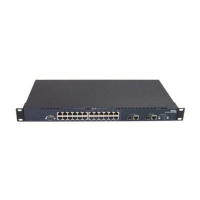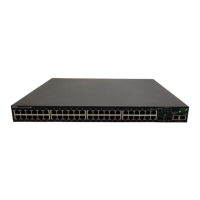362 BigIron RX Series Configuration Guide
53-1002253-01
Edge port and non-edge port states
13
If a port on one bridge has a Designated role and that port is connected to a port on another bridge
that has an Alternate or Backup role, the port with a Designated role cannot be given a Root port
role until two instances of the forward delay timer expires on that port.
Edge port and non-edge port states
As soon as a port is configured as an Edge port, it goes into a forwarding state instantly (in less
than 100 msec).
When the link to a port comes up and RSTP detects that the port is an Edge port, that port instantly
goes into a forwarding state.
If RSTP detects that port as a non-edge port, the port goes into a forwarding state within four
seconds of link up or after two hello timer expires on the port.
Changes to port roles and states
To achieve convergence in a topology, a port’s role and state changes as it receives and transmits
new RST BPDUs. Changes in a port’s role and state constitute a topology change. Besides the
superiority and inferiority of the RST BPDU, bridge-wide and per-port state machines are used to
determine a port’s role as well as a port’s state. Port state machines also determine when port role
and state changes occur.
State machines
The bridge uses the Port Role Selection state machine to determine if port role changes are
required on the bridge. This state machine performs a computation when one of the following
events occur:
• New information is received on any port on the bridge
• The timer expires for the current information on a port on the bridge
Each port uses the following state machines:
• Port Information – This state machine keeps track of spanning-tree information currently used
by the port. It records the origin of the information and ages out any information that was
derived from an incoming BPDU.
• Port Role Transition – This state machine keeps track of the current port role and transitions
the port to the appropriate role when required. It moves the Root port and the Designated port
into forwarding states and moves the Alternate and Backup ports into discarding states.
• Port Transmit – This state machine is responsible for BPDU transmission. It checks to ensure
only the maximum number of BPDUs per hello interval are sent every second. Based on what
mode it is operating in, it sends out either legacy BPDUs or RST BPDUs. In this document
legacy BPDUs are also referred to as STP BPDUs.
• Port Protocol Migration – This state machine deals with compatibility with 802.1D bridges.
When a legacy BPDU is detected on a port, this state machine configures the port to transmit
and receive legacy BPDUs and operate in the legacy mode.

